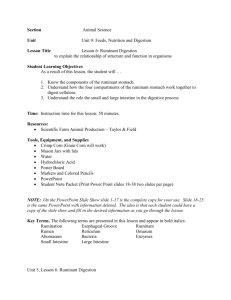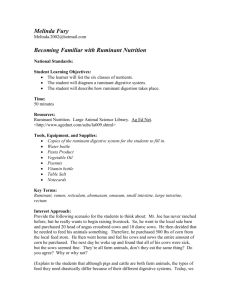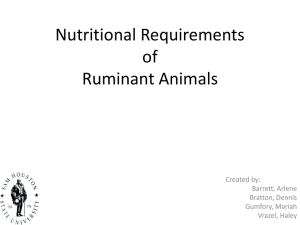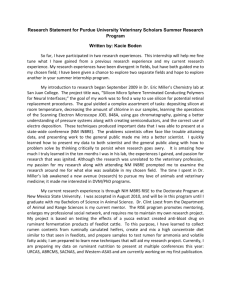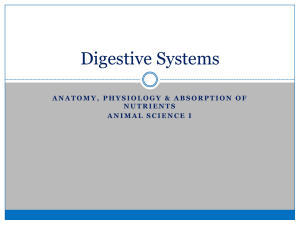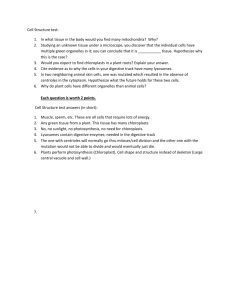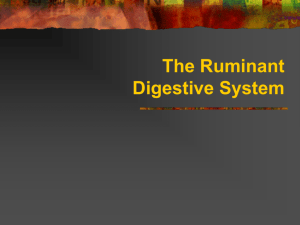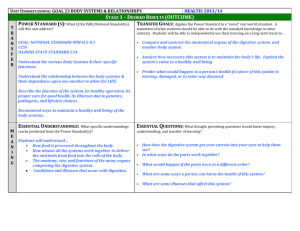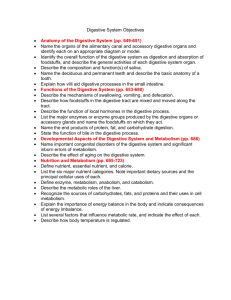Ruminant Digestive Systems Notes
advertisement
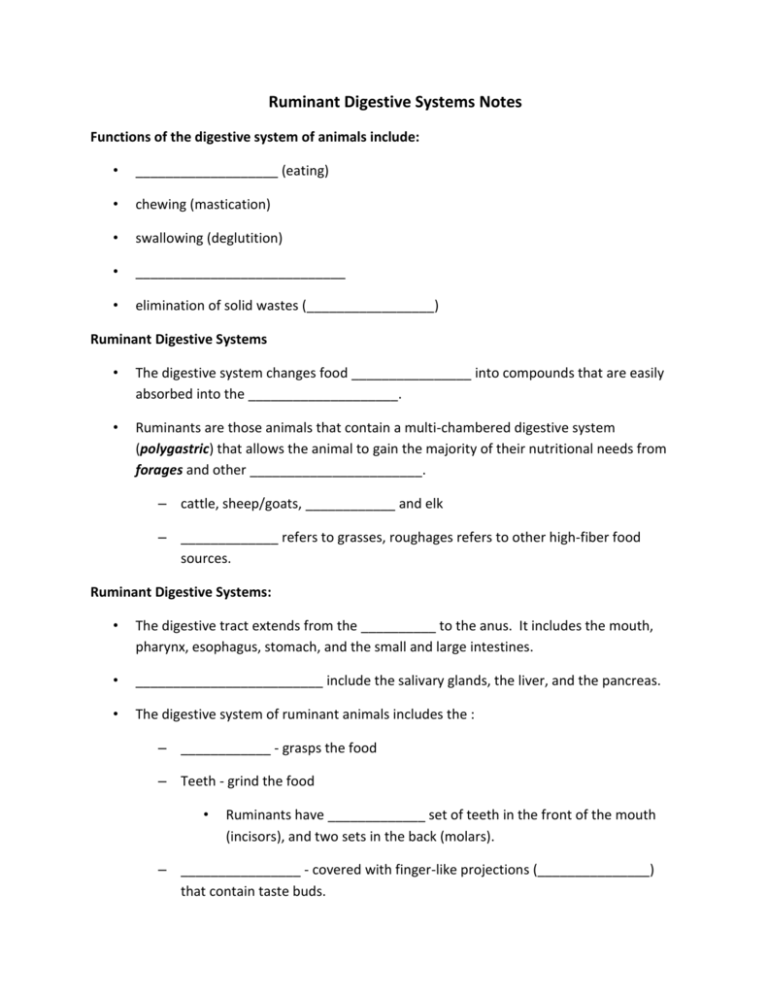
Ruminant Digestive Systems Notes Functions of the digestive system of animals include: • ___________________ (eating) • chewing (mastication) • swallowing (deglutition) • ____________________________ • elimination of solid wastes (_________________) Ruminant Digestive Systems • The digestive system changes food ________________ into compounds that are easily absorbed into the ____________________. • Ruminants are those animals that contain a multi-chambered digestive system (polygastric) that allows the animal to gain the majority of their nutritional needs from forages and other _______________________. – cattle, sheep/goats, ____________ and elk – _____________ refers to grasses, roughages refers to other high-fiber food sources. Ruminant Digestive Systems: • The digestive tract extends from the __________ to the anus. It includes the mouth, pharynx, esophagus, stomach, and the small and large intestines. • _________________________ include the salivary glands, the liver, and the pancreas. • The digestive system of ruminant animals includes the : – ____________ - grasps the food – Teeth - grind the food • Ruminants have _____________ set of teeth in the front of the mouth (incisors), and two sets in the back (molars). – ________________ - covered with finger-like projections (_______________) that contain taste buds. – _______________________ - secrete saliva, that moistens food and is mixed with the food material to aid in swallowing. • Ruminant Digestive Systems – Pharynx - funnels food into the esophagus, preventing food material from entering the lungs. – _____________________ - food tube that leads from the mouth to the stomach. Compartment Capacity • Reticulum _______ of capacity • ________________ 80% of capacity • Omasum 7% of capacity • _________________ 8% of capacity Ruminant Digestive Systems • At this point, ruminant animals have a ______________________ “stomach” – ______________________ - honeycomb-like interior surface, this part helps to remove foreign matter from the food material. – _________________ empties here • Prone to _____________________________: – Cattle swallow small pieces of metal – Can irritate or pierce the lining – Helped by putting a small magnet into the reticulum • Holding area for food; also site of _______________________ – Ruminant Digestive Systems • Ruminant animals grasp mouthfuls of food and swallow it before it is chewed. – They wrap their tongue around a mouthful of grass, clamp down their teeth, and pull to break the grass at its weakest point, and swallow. – Ruminants will “____________________” (regurgitate) their food material and then grind it with their molars at a time when the animal is resting. – This is done until the food particles are small enough to pass through the _________________ into the rumen. Components of Ruminant Digestive System • ______________ - the organ that allows for bacterial and _______________ breakdown of fiber. – The rumen has a very thick, _____________________ wall – It fills most of the left-side of the abdomen • Looks like _____________ due to papillae lining it • _______________________________ – Primary digestion site for ruminants – Microbial digestion takes place here – Breakdown ________________, simple sugars, and __________________ containing compounds like protein • Physical ______________ and breakdown • Not active in the _______________ of life • • Ruminant Digestive Systems _________________ - section that is round and muscular. • “_____________” the food material and prepares the food material for chemical breakdown. • Has many folds in its lining, often said to look like the pages of a book • ________________ particle size of digesta even further • Some ___________________ starts to take place here Ruminant Digestive Systems • __________________ - very similar to the stomach of non-ruminants. • this is where the majority of chemical breakdown of food material occurs. • The “_____________________” of the ruminant animal • Enzyme secretion takes place here • Acts like a ________________stomach • Produces _________, Pepsinogen/pepsin for digestion – Also produces ____________ in early stages of life • Also produces mucus for protection – ____________________ - where most of the food material is absorbed into the bloodstream • Contains three sections: – duodenum – _________________ – ileum • • Ruminant Digestive Systems • The food material is continually squeezed as it is moved through the small intestine, becoming more solid. • The majority of the food material absorption occurs in the duodenum and the jejunum. Ruminant Digestive Systems – _______________________ - begins to prepare unused food material for removal from the body • • a portion of the large intestine in some animals contain pouches that may contain enzymes for further species-specific digestion (horses and rabbits (_____________ )). Ruminant Digestive Systems – Colon - collects the unused food material that is to be removed from the body – _____________ - “poop chute” – _____________ - opening through which the waste is removed. • Controlled by _______________ muscles, that also help protect the opening.
